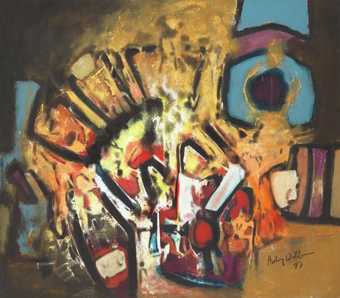
Aubrey Williams
Cosmic Storm (1977)
Tate

Aubrey Williams
Cosmic Storm (1977)
Tate
In 1986, Leicester Museum and Art Gallery invited Aubrey Williams, Bill Ming and me to curate the exhibition Caribbean Expressions in Britain. At the time Williams was 60 years of age, and an artist with an immense knowledge of the art world in Britain and the Caribbean.
My first impression of Williams was that he looked very stately and had a serene calmness. I think we initially connected over music and his paintings of birds from the 1970s – in particular Ural Owl 1975. There is something political and quietly revolutionary about those birds – their stature, their alertness. They make me think about strength, unity and migration. The ability of instant flight, landing on difficult terrain, reorganising and surviving.
In many respects Williams was a visionary and an innovator. He moved from experimental abstract art to more traditional figurative painting and refused to be confined by categories. I also recognised elements of myself in him. I am from St Kitts, he was from Guyana, and our early years played a vital part in our practice – especially questions about decolonisation and the reality of life under British colonial rule, and, for Williams, religious and pre-Columbian indigenous art. I was also fascinated by his range of influences – cosmology, abstract expressionism, music – as well as his technique. His use of vivid colourations and confident yet erratic brushstrokes, which invite you towards initially unnoticed sections of the canvas, demand your attention and ultimate respect. Personally, the painting Cosmic Storm 1977 reminds me of an ancient architectural site viewed from the heavens. In 1966, he co-founded the Caribbean Artists Movement, a group that laid an important foundation for my generation. On reflection, Williams was one of the original Afrofuturists, an artist who provided us with the keys to open the door of artistic freedom.
Organising Caribbean Expressions in Britain was no easy task. Even deciding on a particular approach took time. We knew the exhibition had to rewind the decades, showcasing work by artists from the 1950s and1960s as well as the 1980s, and a desire to focus on shared experiences as opposed to any unifying tradition. But how do you try and capture all those ideas about Britain and the Caribbean? How do you consolidate different modes of expression, from artists like Williams and Ronald Moody to a new generation – Eugene Palmer, Veronica Ryan, Sonia Boyce ,Denzil Forrester – and unite them in a cohesive way? We visited studios throughout Britain, spending time with the artists, engaging in deep and thought-provoking conversations. As curators, we had one opportunity to get it right.
Eventually, we settled on a structure. It was the first time many of these artists had been positioned together. A number had been working in isolation, creating extraordinary and highly complex work, and it was revelatory to see the variety and richness of the art when it was eventually displayed. Meeting Aubrey, absorbing his art, and curating with him has shaped elements of my practice and still inspires me. He taught me the importance of being fearless, embracing one’s cultural legacy and allowing the creative electricity to surge and connect. We are here only once. I try to remember where I have come from – however, where I’m going is the most highly anticipated part of my being.
Cosmic Storm was presented by Andrew Dempsey and Catherine Lampert in 2021.
Pogus Caesar is an artist who lives and works in Birmingham.
To read more of our special feature celebrating Tate Britain's rehang, visit www.tate.org.uk/tate-etc/issue-58-summer-2023/alex-farquharson-tate-britain-the-state-were-in